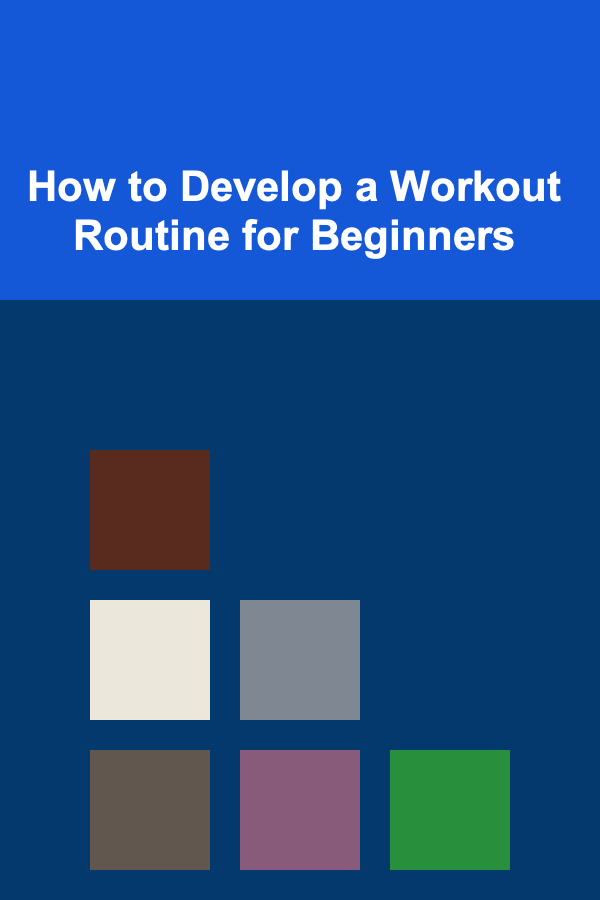
How to Develop a Workout Routine for Beginners
ebook include PDF & Audio bundle (Micro Guide)
$12.99$11.99
Limited Time Offer! Order within the next:

Starting a fitness journey can be overwhelming for beginners, but it doesn't have to be. Developing a workout routine that is both effective and sustainable is essential for creating lasting habits and achieving fitness goals. This article will guide you through the process of designing a workout plan tailored to your needs, abilities, and preferences.
Whether you're looking to lose weight, build muscle, or simply improve your overall health, a well-structured workout routine can set you up for success. Here's how to develop a workout routine that will get you started on the right foot.
Step 1: Establish Your Fitness Goals
Before diving into any workout program, it's important to define your goals. Having a clear idea of why you're exercising will help you stay motivated and provide direction for your routine. The more specific your goals are, the easier it will be to structure your workouts.
Some common fitness goals include:
- Weight loss: If your goal is to shed some pounds, focus on workouts that burn calories and promote fat loss.
- Muscle building: For those who want to increase strength and muscle mass, resistance training is key.
- General fitness: Many beginners simply want to improve overall health and fitness, which requires a balanced approach incorporating cardiovascular exercise, strength training, and flexibility.
- Endurance: Whether it's running a 5K or building stamina for everyday activities, endurance training can be the focus.
- Flexibility and mobility: If you're looking to improve your flexibility or increase joint mobility, incorporate stretching and mobility exercises into your routine.
Step 2: Assess Your Current Fitness Level
Understanding your current fitness level is crucial for designing a workout routine that's challenging yet manageable. If you're new to exercise, start with basic movements and focus on improving your technique before progressing.
How to Assess Your Fitness Level:
- Cardiovascular fitness: Can you comfortably walk or jog for 10 minutes without feeling overly fatigued? A simple test is to measure how long you can sustain a moderate-intensity cardio activity like brisk walking or cycling.
- Strength: Assess your basic bodyweight exercises like squats, lunges, push-ups, and planks. How many can you do with good form? Start with basic exercises to gauge your strength before adding weights.
- Flexibility: Try to touch your toes or perform basic stretches. How far can you reach without straining? Flexibility tests will help determine how much attention you need to give to stretching and mobility.
- Balance and coordination: Try exercises like standing on one leg or performing dynamic movements. Do you struggle with balance or coordination?
If you find certain exercises challenging, start with simpler variations and progressively build your strength, flexibility, and endurance.
Step 3: Choose Your Workout Split
A workout split refers to how you organize your weekly routine based on the type of exercises you're doing. Beginners usually benefit from a full-body workout routine, as it helps build a foundation of strength and endurance. However, as you progress, you may choose a more specialized split, such as focusing on different muscle groups each day.
Full-body Routine for Beginners:
A full-body workout involves targeting all major muscle groups in one session. This is ideal for beginners because it helps develop overall strength and gives your body time to recover between workouts. Aim to work out 3 times per week with at least one rest day between sessions (e.g., Monday, Wednesday, Friday).
Upper/Lower Split:
If you want to increase the intensity of your routine and add variety, consider an upper-lower body split. For example:
- Day 1: Upper body (chest, back, shoulders, arms)
- Day 2: Lower body (legs, glutes, calves)
- Day 3: Rest or active recovery
- Day 4: Upper body
- Day 5: Lower body
- Days 6-7: Rest or active recovery
This type of split is beneficial once you've developed a basic level of fitness and are ready to focus on specific muscle groups.
Step 4: Incorporate Different Types of Exercise
A well-rounded workout routine should include a variety of exercises that target different aspects of fitness. It's important to include the following components in your weekly routine:
1. Cardiovascular Exercise
Cardio exercises get your heart pumping and increase your overall fitness level. They help improve endurance, burn calories, and are crucial for heart health. For beginners, aim for at least 150 minutes of moderate-intensity cardio per week.
- Examples: Walking, jogging, cycling, swimming, jump rope, or using machines like the treadmill, elliptical, or stationary bike.
- Tip: Start with 15-20 minutes of cardio and gradually increase the duration as you build stamina.
2. Strength Training
Strength training builds muscle, increases metabolism, and improves overall body composition. Beginners should start with bodyweight exercises or light dumbbells before progressing to heavier weights.
- Examples: Squats, lunges, push-ups, pull-ups, dumbbell rows, bicep curls, tricep dips, deadlifts, etc.
- Tip: Focus on proper form and technique to avoid injury. Start with 2-3 sets of 8-12 reps for each exercise.
3. Flexibility and Mobility
Improving flexibility and mobility helps prevent injury and enhances your range of motion. Stretching can also relieve muscle tension and promote relaxation.
- Examples: Dynamic stretches (e.g., leg swings, arm circles), static stretches (e.g., hamstring stretch, quad stretch), and yoga poses (e.g., downward dog, cobra, child's pose).
- Tip: Perform static stretches after your workouts when muscles are warm to improve flexibility.
4. Balance and Coordination
Balance exercises are important for overall functional fitness, and they help with posture, stability, and injury prevention. Many beginner exercises also enhance coordination.
- Examples: Standing on one leg, doing squats or lunges with a balance challenge, stability ball exercises, or using a balance board.
- Tip: Add balance exercises towards the end of your workout routine for a great cool-down.
Step 5: Create a Balanced Weekly Routine
Now that you understand the key components, let's build a sample weekly routine for beginners. The goal is to create a routine that challenges you without overloading your body, especially in the early stages of your fitness journey.
Here's an example of a beginner's weekly workout plan:
Monday: Full-body Strength Training
- Squats: 3 sets of 12 reps
- Push-ups (modified or regular): 3 sets of 10 reps
- Dumbbell Rows: 3 sets of 12 reps
- Plank: 3 sets, hold for 20 seconds
- Lunges: 3 sets of 10 reps per leg
Tuesday: Cardio & Mobility
- Brisk walking or cycling: 30 minutes
- Dynamic stretches (leg swings, arm circles, etc.): 10 minutes
- Static stretches (hamstring stretch, hip flexor stretch, etc.): 10 minutes
Wednesday: Rest or Active Recovery
- Light yoga or stretching session: 20-30 minutes
- Go for a walk or do a gentle swim
Thursday: Upper-body Strength Training
- Dumbbell Chest Press: 3 sets of 12 reps
- Bent-over Dumbbell Rows: 3 sets of 12 reps
- Shoulder Press: 3 sets of 12 reps
- Bicep Curls: 3 sets of 12 reps
- Tricep Dips: 3 sets of 10 reps
Friday: Cardio
- Jogging or brisk walking: 30 minutes
- Interval training: Alternate 1 minute of brisk walking with 1 minute of fast walking for 20-30 minutes
Saturday: Lower-body Strength Training
- Deadlifts (with light weight): 3 sets of 12 reps
- Glute Bridges: 3 sets of 15 reps
- Step-ups (with or without dumbbells): 3 sets of 12 reps per leg
- Calf Raises: 3 sets of 15 reps
Sunday: Rest or Active Recovery
- Light stretching or yoga
- Go for a walk or swim at a relaxed pace
Step 6: Track Your Progress and Adjust Your Routine
Tracking your progress is essential for staying motivated and ensuring that you're moving towards your goals. Keep a workout journal where you log your exercises, sets, reps, and any notes about how you felt during your workout.
As you continue to exercise, aim to gradually increase the intensity, duration, or volume of your workouts to avoid plateaus and keep progressing. This could mean adding weight to your strength training exercises, running for longer distances, or adding more challenging variations to your workouts.
Step 7: Listen to Your Body
It's important to listen to your body throughout your fitness journey. If you feel fatigued, sore, or experience discomfort during a workout, don't push through it. Rest and recovery are essential for avoiding injuries and allowing your body to adapt to the training stimulus.
Incorporate rest days into your routine, prioritize sleep, and pay attention to any signs of overtraining. Rest is when your muscles recover and grow stronger.
Conclusion
Developing a workout routine as a beginner doesn't need to be complicated. By starting with clear goals, assessing your fitness level, and incorporating various types of exercise, you can create a balanced and effective workout plan. As you build your strength, endurance, and confidence, you'll be able to progress to more challenging routines and continue to reap the benefits of regular exercise.
Remember to be patient with yourself, stay consistent, and celebrate your progress. Fitness is a lifelong journey, and each step you take brings you closer to a healthier and stronger version of yourself.

How to Build a Positive Body Image in Your Child
Read More
How to Use Mirrors to Create a Sense of Space in Staging
Read More
Innovation Nation: How to Stand Out by Embracing Disruptive Technologies
Read More
The Ultimate Guide to Utilizing Loyalty Programs for Smart Shopping
Read More
How to Navigate Crypto Regulations
Read More
Optimizing Protein Intake for Muscle Preservation: A Comprehensive Guide
Read MoreOther Products

How to Build a Positive Body Image in Your Child
Read More
How to Use Mirrors to Create a Sense of Space in Staging
Read More
Innovation Nation: How to Stand Out by Embracing Disruptive Technologies
Read More
The Ultimate Guide to Utilizing Loyalty Programs for Smart Shopping
Read More
How to Navigate Crypto Regulations
Read More